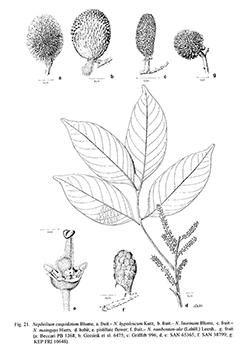e-Flora of Thailand
Volume 7 > Part 1 > Year 1999 > Page 231 > Sapindaceae > Nephelium
7. Nephelium ramboutan-ake (Labill.) Leenh.wfo-0001243912
Blumea 31: 415. 1986 (see also for complete synonymy); Yap in Tree Fl. Mal. 4: 454. 1989; Leenh. in Fl. Males., Ser. 1, Spermat. 11: 689, fig. 60i. 1994.— Litchi ramboutan-ake Labill. in DC., Bull. Soc. Philomath. Paris 2: 161. 1801. Fig. 21g.
Accepted Name : This is currently accepted.
Synonyms & Citations :
Description : Trees up to 10(–36) m high; bark usually reddish, brownish or greyish, usually smooth or with minute lenticels; young branches subglabrous. Leaves 1–7-jugate; young rachises subglabrous at most. Leaflets (ovate to) elliptic (to obovate), 4–120 by 1.8–11 cm, papyraceous; base acute or obtuse to rounded to attenuate in lower leaflets; margins convex, often rolled up when dry; apex mostly acuminate; domatia present; glabrous to puberulous on midrib above, usually short hairy to glabrous underneath. Inflorescences axillary, partly together pseudo-terminal. Flowers pale green or white, small, slightly scented. Sepals hardly to up to halfway connate, lobes deltoid, 1–2.75 mm high. Petals absent. Stamens 5–8; filaments white, anthers light yellow. Ovary 2(–4)-locular. Fruits yellow, red or green; lobes ellipsoid to subglobular, 4–6.5 by 2.5–5 cm, covered with short, up to 1(–1.5) cm long, blunt spines; wall coriaceous, up to 7 mm thick.
Thailand : PENINSULAR: Yala (Ban Pari).
Distribution : Assam, Burma, Malay Peninsula, Sumatra, Java (doubtful), Borneo, the Philippines, Moluccas.
Ecology : Primary and sometimes secondary evergreen forests on flats and slopes, often on river banks, but rarely in swamps; soil usually sand or clay, rarely rocky like sandstone and basalt or even limestone; sea level up to 200(–1,950) m alt. Flowering: mainly February–April and July–September; fruiting: May–July and October–December.
Vernacular : Kho laen (คอแลน), krat (กรัด), ngo khon san (เงาะขนสั้น)(Peninsular).
Uses: Cultivated as a fruit tree (and then commonly known as Nephelium mutabile), but more difficult to cultivate than Nephelium lappaceum. See Seibert in Verheij & Coronel (eds.), Pl. Res. S.E. Asia (PROSEA Handb.) 2, Edible fruits and nuts: 233. 1991.
Notes: Only tentatively added as part of the Thai flora, because of a single specimen (Lakshnakara 675, Ban Pari) which may have been introduced.

